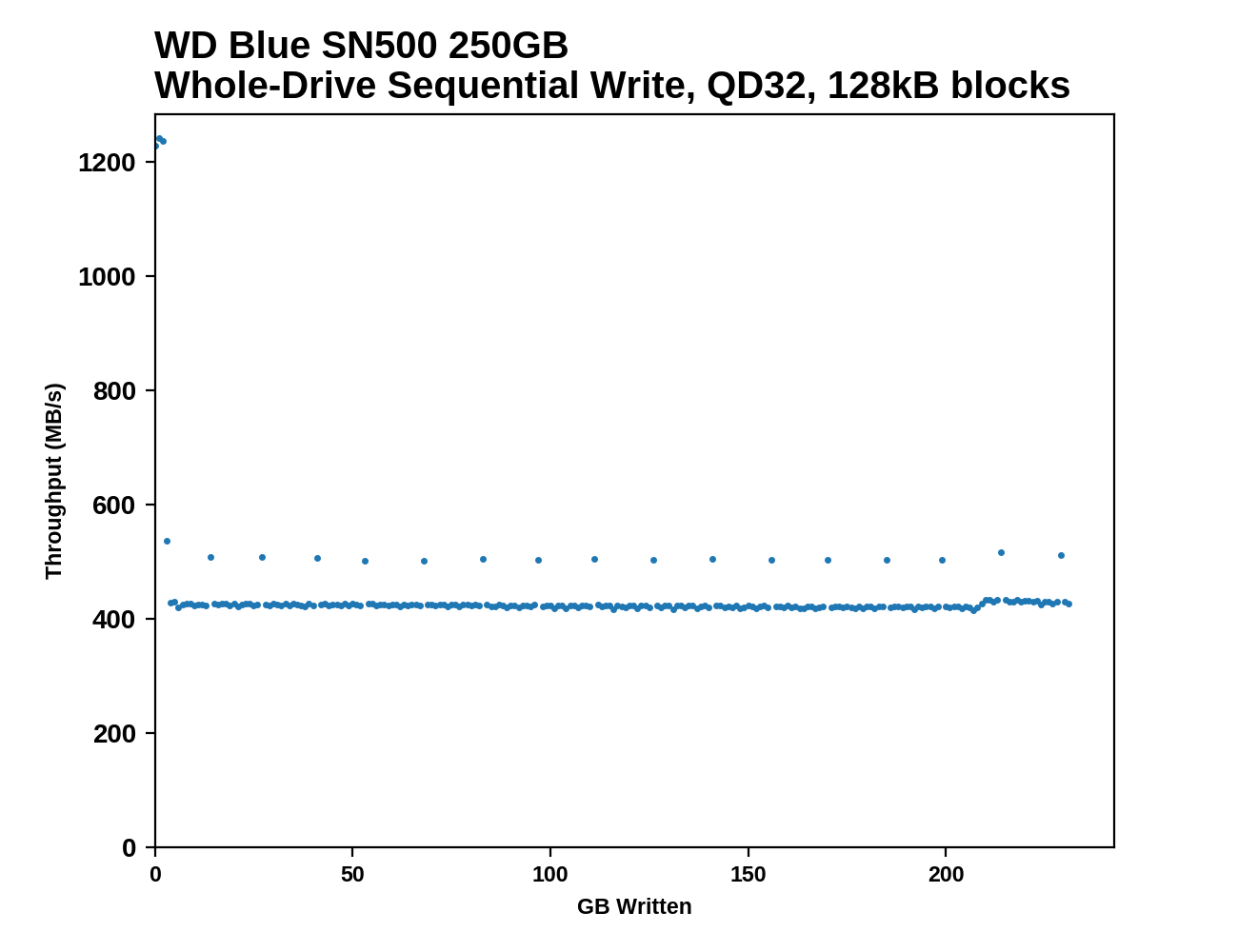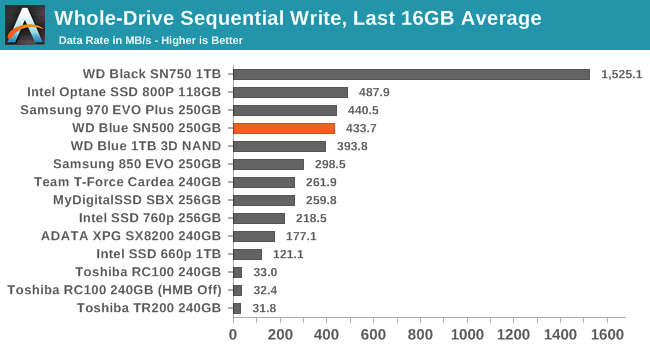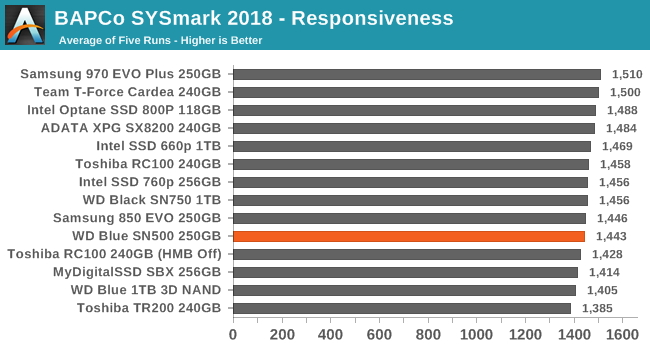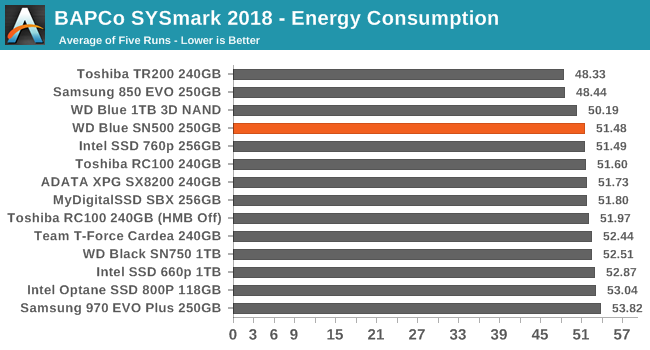The Western Digital WD Blue SN500 SSD Review: Moving The Mainstream To NVMe
by Billy Tallis on April 19, 2019 9:30 AM ESTWhole-Drive Fill
This test starts with a freshly-erased drive and fills it with 128kB sequential writes at queue depth 32, recording the write speed for each 1GB segment. This test is not representative of any ordinary client/consumer usage pattern, but it does allow us to observe transitions in the drive's behavior as it fills up. This can allow us to estimate the size of any SLC write cache, and get a sense for how much performance remains on the rare occasions where real-world usage keeps writing data after filling the cache.
 |
|||||||||
The 250GB WD Blue SN500's SLC write cache lasts for a mere 3GB before the write speed drops down to SATA speeds. After the cache is exhausted, the write speed is very consistent, with periodic short of higher performance that last for less than 1GB.
 |
|||||||||
| Average Throughput for last 16 GB | Overall Average Throughput | ||||||||
The SN500's sustained sequential write speed of about 432MB/s doesn't make much use of the speed offered by the PCIe host connection, but it's very good for a drive in this capacity class: the Samsung 970 EVO Plus is barely any faster, though its SLC cache is much larger. None of the other low-end NVMe drives we've tested come close to sustaining the long-term write performance that the SN500 provides.
Working Set Size
Most mainstream SSDs have enough DRAM to store the entire mapping table that translates logical block addresses into physical flash memory addresses. DRAMless drives only have small buffers to cache a portion of this mapping information. When accessing a logical block whose mapping is not cached, the drive needs to read the mapping from the full table stored on the flash memory before it can read the user data stored at that logical block. This adds extra latency to read operations and in the worst case may double random read latency.
We can estimate the size of any on-controller mapping buffer by performing random reads from different sized portions of the drive. When performing random reads from a small slice of the drive, we expect the mappings to all fit in the cache, and when performing random reads from the entire drive, we expect mostly cache misses.
When performing this test on mainstream drives with a full-sized DRAM cache, we expect performance to be generally constant regardless of the working set size, or for performance to drop only slightly as the working set size increases.
 |
|||||||||
The SN500 offers good random read IOPS for working set sizes up to about 4GB before performance begins to decline. Based on the usual ratio of requiring 1MB of mapping data cache per GB of storage, it looks like the SN500's controller devotes around 4MB of SRAM to this purpose. That's significantly smaller than the typical Host Memory Buffer sizes used by DRAMless NVMe SSDs that implement that feature. For example, the Toshiba RC100 uses an HMB of 38MB and maintains random read performance out to at least 24GB working set sizes.
While the SN500's cache of address mapping data may be rather small, it is clearly plenty fast: for small working set sizes, the SN500's random read performance is higher than the WD Black SN750.
BAPCo SYSmark 2018
BAPCo's SYSmark 2018 is an application-based benchmark that uses real-world applications to replay usage patterns of business users, with subscores for productivity, creativity and responsiveness. Scores represnt overall system performance and are calibrated against a reference system that is defined to score 1000 in each of the scenarios. A score of, say, 2000, would imply that the system under test is twice as fast as the reference system.
SYSmark scores are based on total application response time as seen by the user, including not only storage latency but time spent by the processor. This means there's a limit to how much a storage improvement could possibly increase scores, because the SSD is only in use for a small fraction of the total test duration. This is a significant difference from our ATSB tests where only the storage portion of the workload is replicated and disk idle times are cut short to a maximum of 25ms.
| AnandTech SYSmark SSD Testbed | |
| CPU | Intel Core i5-7400 |
| Motherboard | ASUS PRIME Z270-A |
| Chipset | Intel Z270 |
| Memory | 2x 4GB DDR4-2666 CL15 |
| Case | In Win C583 |
| Power Supply | Cooler Master G550M |
| OS | Windows 10 64-bit, version 1803 |
Our SSD testing with SYSmark uses a different test system than the rest of our SSD tests. This machine is set up to measure total system power consumption rather than just the drive's power.
 |
|||||||||
| Creativity | Productivity | Responsiveness | Overall | ||||||
Only the Responsiveness subscore shows a meaningful difference between SSDs of similar capacities, and even then the difference between the top NVMe drives and the slowest DRAMless SATA drives is fairly small. The WD Blue SN500's Responsiveness score is a bit slower than average for this bunch of SSDs, but as more of an entry-level NVMe drive this isn't a disappointment for the SN500.
Energy Usage
The SYSmark energy usage scores measure total system power consumption, excluding the display. Our SYSmark test system idles at around 26 W and peaks at over 60 W measured at the wall during the benchmark run. SATA SSDs seldom exceed 5 W and idle at a fraction of a watt, and the SSDs spend most of the test idle. This means the energy usage scores will inevitably be very close. A typical notebook system will tend to be better optimized for power efficiency than this desktop system, so the SSD would account for a much larger portion of the total and the score difference between SSDs would be more noticeable.

The WD Blue SN500 is one of the most efficient NVMe drives in its capacity class, but the SATA drives still take all the top scores for energy consumption over the course of a SYSmark run. There are several faster NVMe drives that have power requirements only slightly above the SN500 despite including the DRAM cache the SN500 lacks.










50 Comments
View All Comments
Marlin1975 - Friday, April 19, 2019 - link
Actually not bad for one that does not have any large external buffer. That and this is the 250gb model so the 500 should perform a little better as well.Dragonstongue - Friday, April 19, 2019 - link
970 Evo Plus quite stands out for NVME based drives at ~$35 more for same size (just did a price check, amazon, 500gb for this vs 970 evo plus)so while "on paper" this appears great price, is still in very tough ground with ample contendors such as crucial with their p3 ( I believe it was called) countless samsung entries and the like.
for an extra ~$30-$40 seems like "normally" is just not worth it when can do for ones self (such as clock up the slower product, tweaking voltages and the like) when it comes to a "paper" difference and more or less proven real world data this is not all that good a price.
IMO is we take even a high performance HDD as a regular car speed, sata ssd (even highest performance) still is like an expensive supercar speed difference, the next jump would be the nvme based ones which are like top fuel dragsters (at best) but few tracks let them breathe proper and have to deal with engine problems (throttling etc) that normal drive do not have to deal with AND more $$$$$$..
top fuel costs $$$$, do you ALWAYS see this speed, nope, but when you do, is wonderful, when you do not, it becomes a "so why did I pay that much more for little gain and loss in capacity as well as specific motherboards to tap the advantage" etc etc.
kudos to WD, but alas, the margins are so very narrow and expected performance so high is near a non starter for all companies.
I feel the "new standard" for storage should be @500gb for performance and capacity reasons with 1tb prefered (even a 250nvme + whatever size SSD flash in a raid internal no driver required fashion .. I always liked concept of hybrid drives, why not use hybrid memory styles to leverage as well, instead of saddling fast memory with spinning rust, use high speed low endurance flash with lower speed high endurance other flash.
they do pci-e basd, nvme based, sata based etc etc, all have own benefit and detriment. I personally love sata based, leave the motherboard real estate for other things, they should do a further rendition of sata for the hole outs (like me and others whom have a variety of reasons)
if they can patch pci-e to nvme, why not use sta 6 (like current) but tap x2 or x4 pci-e lanes to it as well, let us call it SATA-X, backwarrds compatible with Sta 6g to sata 1 ofc, this would allow some sata or whatever drives up their speed but use a familiar/durable/more widespread form factor.
if all nvme based drives would work in all board or they would not interfere with mobo, not have throttle issues because of dog meta cooling designs (motherboard AND drive maker often enough) it would not be as much an issue, I like sata drive for such reasons, mainly can look "nicer" tend to be much more durable, that much less costly etc etc.
anyways, if WD could do 500 for the price of the 250, that would be most excellent, but as the pricing is, mehhh, overall nice rounded performance with no real shortcomings compared to many others even some of the much more $ drives are not as "rounded" for this they at least did very well at, that much should be said.
like Crucial with MX100, MX500, Samsung with the 800 through 970s (sata and nvme ofc) there are levels that are nice to hit, this SN500 is very much on that edge, up the performance a tough more, reduce price a touch (keep say $40 or better gap between this and the 970 evo plus) then this is that new "leg"
crucial 100/mx500 are more "budget" compared to the "sometimes" faster sammy 8xx/9xx drives, sammy ofc got the speed and endurance markers out there, this "could be" that leg of "rounded performance" just like the mx500 or sammy 8xx/9xx evo ^.^
sonny73n - Saturday, April 20, 2019 - link
Is this a comment or an essay?Hul8 - Saturday, April 20, 2019 - link
"Stream of consciousness" is a style, but usually only applied to fiction.LMonty - Sunday, April 21, 2019 - link
Haha! He just needed to get it out of his system :)Thud2 - Saturday, April 20, 2019 - link
Can you elaborate?Jorgp2 - Sunday, April 21, 2019 - link
Pretty sure this is targeted mostly at OEMsDyneCorp - Wednesday, April 24, 2019 - link
The MX500 is on par with the 860 EVO. SSDs with Micron 64-layer 3D TLC NAND and the SM2262 controller (HP EX920 and ADATA SX8200) absolutely destroy Samsung 9 series NVMe SSDs in certain metrics.The initial price of any product is always high. The SN500 will drop in price. In fact, its not even selling at its suggested retail price from most retailers.
And by the way, comparing SSDs to motor vehicles is ridiculous. Please stop.
jabber - Friday, April 19, 2019 - link
It will do fine for a Steam drive.fazalmajid - Friday, April 19, 2019 - link
I don’t see how such puny capacities can be mainstream, specially when most motherboards or laptops have a limited number of M.2 slots. My minimum would be a 1TB or 2TB Intel 660P.